Note that the headline says “attracting,” not “targeting.”
People hear targeting and think media choices — are you on the wrong station, in the wrong magazine or newspaper, or hitting the wrong demographics or keywords with your digital campaigns?
That’s not what I’m talking about.
Who you attract depends more on messaging than media.
And it has far more to do with psychographics and motivations than demographics.
In short, we’re answering the questions:
What are you saying and who finds that message appealing?
Understanding Relational vs. Transactional Buying Modes
This is a big topic, but in simple terms, the most important messaging choice boils down to whether you’re attracting Relational or Transactional customers?
Now, keep in mind that relational and transaction are buying modes, not permanent labels.
Everyone buys some things transactionally and others relationally.
One old school example is gas.
Some people pay attention to the price of gas and will go to the station with the lowest price, even if it’s a different station every time. They’re shopping transactionally.
Others always get their gas from the same one or two places, because of location, lighting, brand of gas, pay at the pump options, or how nice the attached convenience store is, etc. They’re shopping relationally.
Another example might be eggs. Some people buy flats of eggs to get the best possible price, because “eggs are eggs.”
Others only buy Certified Humane, Pastured, Organic eggs because the health of the hens determines the quality of the eggs.
But it’s not only that one’s a price shopper and the other isn’t. Here’s a summary of all the other ways they differ:
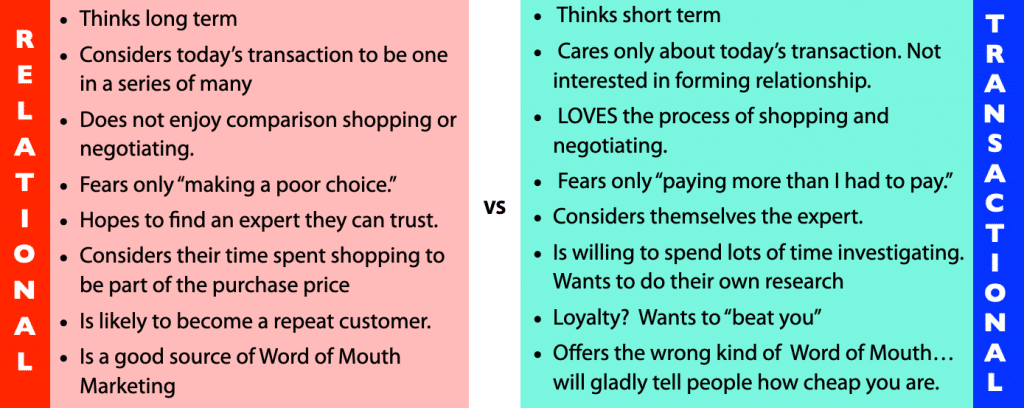
For transactional customers, getting the best deal is the goal, and time spent researching, comparison shopping, and negotiating are the “price” one pays to get that deal.
For Relational customers, getting the full benefit they’re after with a minimal investment of time and cognitive effort is the goal, and they accept that paying for others’ experience, expertise, and service is the “price” that buys that benefit.
Relational vs. Transactional and The Dangers of a Business-Marketing Mismatch
To be clear, both relational and transactional customers can be profitable.
But only if your business is set up to service them.
Walmart is a classic example of a successful low-price business designed for transactional customers. Hence their slogan: “Always Low Prices.”
And because Walmart is set up to be a low-priced provider, it works.
They squeeze vendors to keep their costs low, and they make a 15% margin workable through massive inventory turn.
The problem comes when your business strategy and advertising messaging are mis-matched.
A business set up to service relational customers who’s ads attract transactional customers will experience a lot of heartache because of it.
That business will never have the low prices transactional customers demand.
Plus they’ll never get the added pay-off that comes with long-term loyal customers.
But before we get into how to properly attract relational customers, let’s take a look at why they’re such a powerful driver of profit.
Modeling Relational vs. Transactional Customers for Traffic, Sales, Revenue, and Margin
Consider the following a “classical” modeling of the two buying modes.
Classical in that it’s simplified and idealized for the sake of maximum clarity.
And also, ‘cause it’s a wee bit dated, from back when people bought Blu-Ray players and did their comparison shopping in store rather than online.
Yet, none of that takes away from the effects and dynamics we are trying to understand, so don’t let it distract you.
So let’s say 10 people are shopping for a Blu-Ray player, with a 50-50 split of transactional vs. relational buying modes.
The 5 relational buyers’ shopping behavior will look like this:
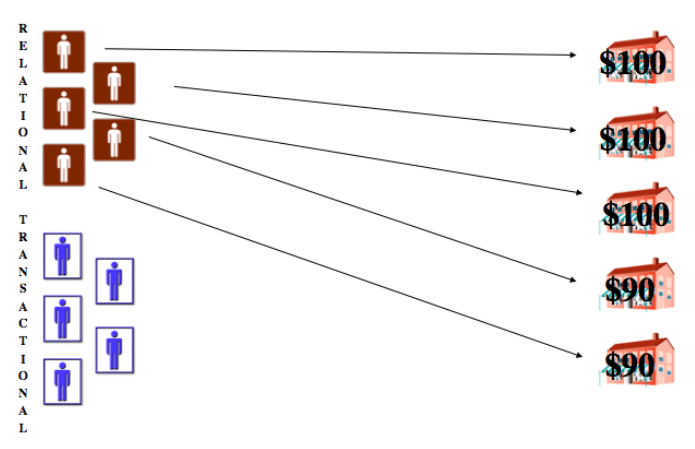
Each Relational buyer goes to their trusted source for electronics or home theatre and buys the model that’s recommended to them.
In contrast, the 5 Transactional buyers’ shopping behavior will look like this:
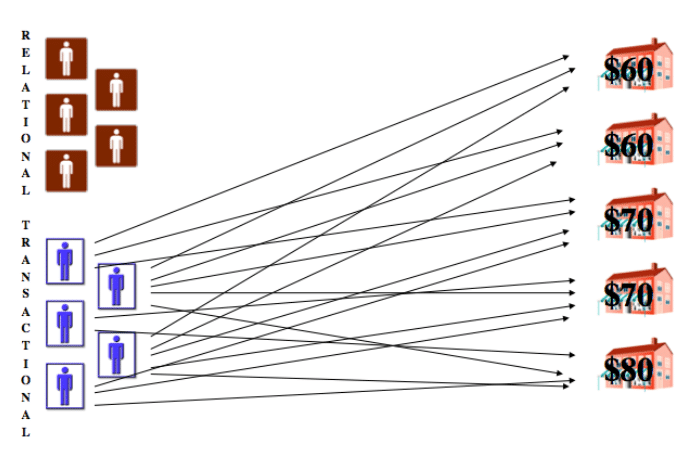
Each Transactional shopper visits between three to five stores looking for the best deal (having already researched the best “bang for your buck” Blu-Ray player they want).
When they finally find the store with the lowest anticipated price, they buy it.
Relational vs. Transactional Customers and Traffic
Since the Transactional Shoppers visit an average of four times as many stores, they account for a vastly disproportionate amount of store (or Web) traffic.
Yet, despite this fact, Transactional Shoppers only represent half the buyers:

Yet it’s when we get to looking at revenue numbers that the picture changes even further:
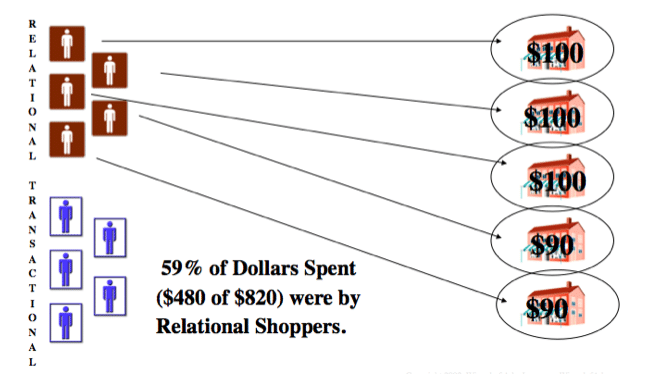
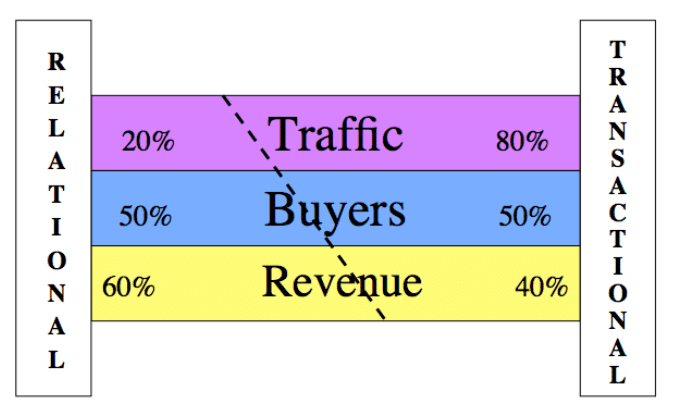
And the real difference comes when we look at profit margins:
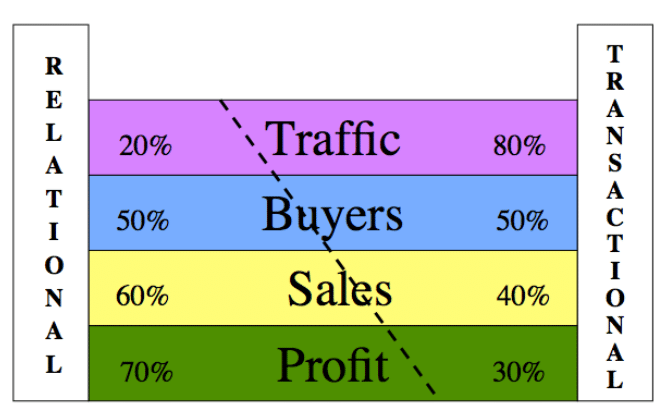
So the answer to “why target relational customers instead of transaction is simple:
Profit Margin!
And perhaps even more important is customer loyalty.
By their very nature, relational customers are loyal customers when they find a relational provider.
Whereas transactional customers are, well, transactional — their loyalty hinges on price.
Where Most Advertisers Go Wrong
Given that there’s a 50-50 split between Transactional and Relational buyers for most categories, you’d expect to see a similar split between messages aimed at each buyer.
Or, given the disproportionate amounts of revenue and profit generated by Relational buyers, you might even expect an over-abundance of messaging aimed at Relationals.
But that’s not what you find.
Instead the advertising split looks like this:
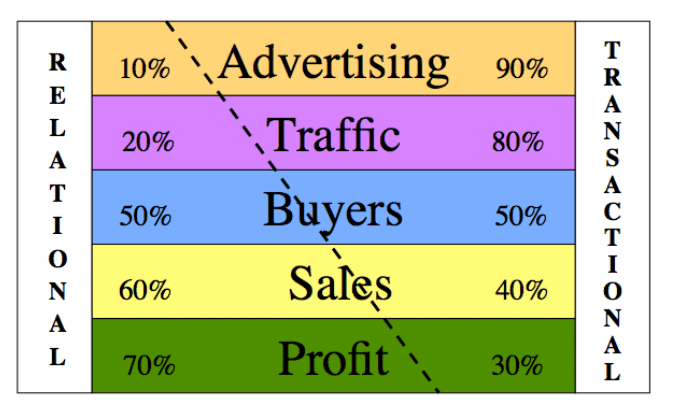
90% of the ads on the air — especially ads on the radio — are advertising price:
- Ads for sales.
- Ads for special items at discounted pricing (e.g., most tune-up specials)
- Ads for “loss leaders” and lead-gen offers
- Ads claiming “we will not be undersold”
- Even ads (stupidly) claiming “competitive pricing”
And the real problem starts when a Relational company accidentally advertises with this kind of messaging.
In service companies this seen when the Transactional ads bring in tire kickers who end up not buying, forcing the company to apply a minimum “service” fee in order to screen out the very customers they paid to attract!
Why Most Ads Don’t Attract Relational Customers
So why don’t more companies aim to attract Relational customers?
A number of reasons:
- Most relational style ads don’t sound like ads, which scares off too many business owners that want “professional sounding ads.”
- Relational advertising requires you to “walk away from” Transactional buyers, and too many biz owners are scared to do that, seeking to be all things to all customers.
- Relational advertising requires vulnerability and self-disclosure on the part of the advertiser.
- Advertisers are more interested in immediate response and traffic than long-term attraction of and bonding with relational customers.
In short, you have to put out a relational message to capture Relational buyers, and relational messages aren’t just about expertise or quality.
Relational messages are invariably about values and business philosophy (hence the success of Origin Stories in attracting Relational customers)
And for those kinds of messages to work, they can’t be faked.
That said, some companies have figured out the value of Relational Buyers.
In fact, Apple does this brilliantly.
Apple as a Case Study in Attracting Relational Buyers
Think about what Apple promises its customers.
It’s never that you’ll get the best price. Or even that you’ll have the most features and specs.
Apple always promises that your user experience will be everything you’re hoping it will be.
That you’ll for sure make the right choice with an Apple product, that the support will be so much better, and that everything will “just work.”
This is messaging aimed straight at the heart of the Relational buyer.
And it works, which is why they can consistently sell a relatively small fraction of total computers and tablets while reaping the lion’s share of the profits.
For example, currently Apple sells 39% of the smart phones in the U.S. while capturing 66% of the profit.
It’s also why they have an army of Apple loyalists willing to buy their latest and greatest stuff, every time they release something new.
So in a world of ads screaming about low prices, sales, and discounts, make your ads stand out from the crowd.
And do it while attracting the most profitable prospects by advertising to the Relational customer.
P.S. As I mentioned earlier, Origin Stories are a magnificent way to attract Relational Customers. For those looking to learn how to tell their own Origin Story, I will be teaching an online class on Origin Stories later this month. And readers of my posts can get a 30% discount by using the code: “jeffsentme”
- Are You Paying for Too Much for the Wrong Keywords? - July 15, 2024
- Dominate Your Market Like Rolex — 4 Powerful Branding Lessons - July 3, 2024
- Military-Grade Persuasion for Your Branding - June 25, 2024
